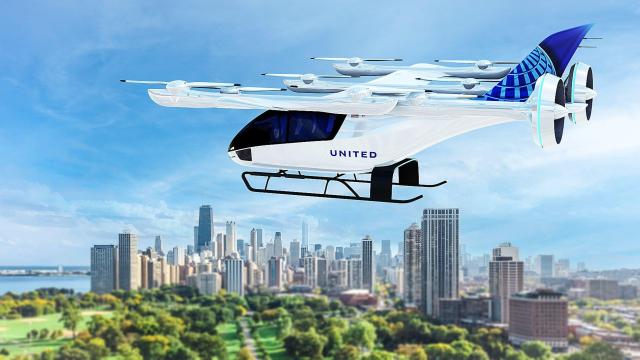If the prospect of flying electric taxis zooming to and from major airports via an app sounds like a pie in the sky, try not to tell United Airlines.
On Thursday the airliner announced a $US15 ($21) million investment into electric vertical take-off and landing vehicle startup Eve Air Mobility along with a conditional purchase agreement for 200 of the firm’s so-called flying taxis. United’s betting big on these helicopter-like, supposedly zero-emission electric aircraft to revolutionise mid-length urban air travel. Whether or not that bet will actually pay off still remains far from certain.
The investment builds upon another $US10 ($14) million United invested in flyng taxi firm Archer earlier this year. United had previously agreed to purchase 100 aircraft from Archer. Now, through its deal with Eve, United says it hopes to have first deliveries of aircraft by 2026. United says it also has options for 200 additional aircraft.
“Our agreement with Eve highlights our confidence in the urban air mobility market and serves as another important benchmark toward our goal of net zero carbon emissions by 2050 – without using traditional offsets,” Michael Leskinen, President of United Airline’s ventures said in a statement. “Together, we believe our suite of clean energy technologies will revolutionise air travel as we know it and serve as the catalyst for the aviation industry to move toward a sustainable future.”
United claims Eve’s design, which it says, “favours safety, efficiency, reliability and certifiability,” has a range of around 97 km which is notably shorter than other major competitors in the field. Eve’s electric design is inherently quieter though, with United claiming its use could reduce noise levels by around 90 per cent compared to current conventional aircraft.
Who else is getting in on the action?
United isn’t the only major airliner opening up its pocketbooks for sky taxis. Earlier this year, American Airlines announced it would pre-order 250 VX4 flying taxis from the firm Vertical Aerospace. Those aircraft, according to Business Insider, are reportedly capable of carrying four passengers up to 100 miles and speeds topping 241 km/h. In total, Vertical Aerospace told Business Insider it already has around 1,400 conditional pre-orders from major airliners including Virgin Atlantic, AirAsia, and Japan Airlines.
Maybe the biggest name in the space so far is Santa Cruz-based aviation startup Joby, which went public via a SPAC in late last year. Founded in 2009, Joby stands out as one of the more mature startups in the space and claims its six propeller-based eVTOLs can achieve a range of around 241 km flying at a maximum of 322 km per hour. Joby wants eventual customers to summon one of its vehicles using an app, leading some to call it the “Uber of the air.” It also doesn’t hurt either that Joby literally bought Uber’s experimental flying taxi division in 2020. A PR firm representing Joby previously told Gizmodo it somehow plans to one-day offer rides around the same price as an Uber X.
Earlier this year, Joby announced it received one of three Federal Aviation Administration approvals necessary to allow it to operate its aircraft commercially. That approval means Joby can technically operate as an aircraft but it still needs to acquire more approvals to actually transport people with its experimental eVTOL.
Will it work?
Depending on how you look at it, flying taxis, or eVTOLs are either a revolutionary new mode of eco-friendlier mid-distance travel or a quieter, glorified helicopter. United and many other airlines’ current plans for these vehicles, to serve as high-speed taxis to and from distant airports, certainly seems to play to that later description. As Gizmodo previously noted, flying taxis as a concept date back decades, and hype around the next big potential commercial success story ebs and flows, following a similar path to that of driverless cars.
But this time, airlines and eVTOL startups assure us, things are different. United, Joby Aviation, and even The New York Times have all estimated flying taxis may finally become a reality within, “a few years,” with some placing that commercialization as quick as 2024. One thing’s for certain; there’s no shortage of money flowing in to make that happen. Research conducted by Morgan Stanley in 2020 estimates recent advances in the autonomous urban aircraft space means the total market could be worth $US1.5 ($2) trillion by 2040.
“The intersection of many technologies, such as ultra-efficient batteries, autonomous systems, and advanced manufacturing processes are spawning a flurry of activity in this space,” says Adam Jonas, Head of Morgan Stanley’s Global Auto and Shared Mobility said in a statement.
